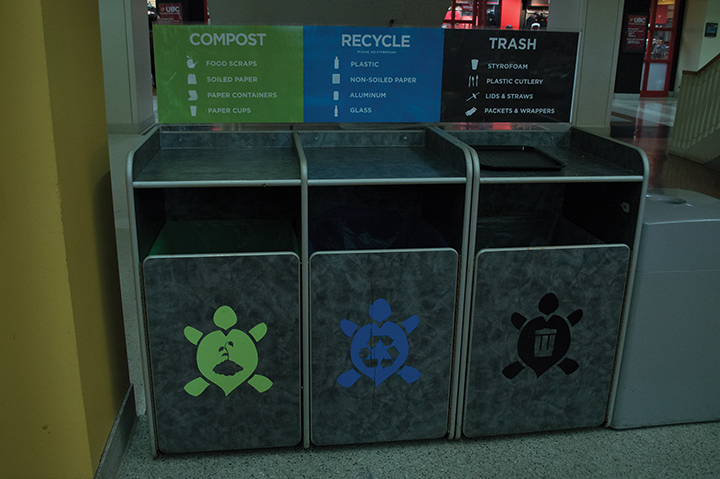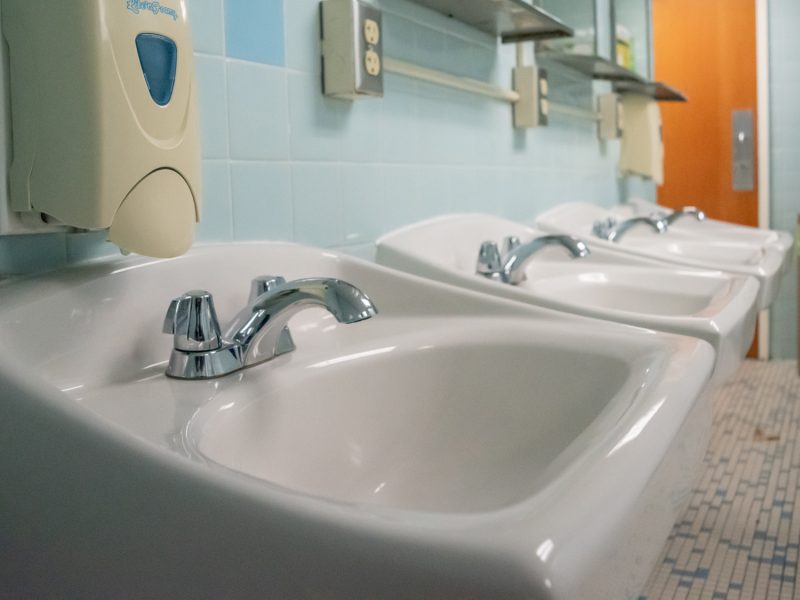The University of Maryland is in the process of expanding its composting program, with more than 25 composting collection sites — including 12 inside dorms — now on the campus.
Before this year, 11 dorms and about five academic buildings had composting, but buildings such as St. Mary’s Hall, McKeldin Library and the Edward St. John Learning and Teaching Center have recently gotten compost bins.
The goal is to add composting bins to buildings every two weeks “as long as we have the resources to do so and [until] we have compost collection in all of the administrative and academic buildings on campus,” said Adrienne Small, a Facilities Management recycling specialist. The Service Building and Turner Hall will come next, she said.
“I am really excited that we got the green light to expand composting,” Small said. “This has been a constant request from students, faculty and staff, and it was individuals continually expressing their desire to see more composting on this campus that has made the expansion possible.”
[Read more: UMD’s transition to Anytime Dining has saved more than 6 million disposable products]
Andrew Muir, this university’s Office of Sustainability spokesman, said the expansion of composting “started to get going” with a $50,400 sustainability fund grant to bolster the compost collection, which was awarded during the 2014-15 academic year and used to purchase a compactor for the campus.
The University Sustainability Fund gives funding for campus projects that promote environmental sustainability and is provided by a $6 fee per full-time undergraduate student each semester.
Small said besides helping the environment and keeping this university above the goal for its diversion rate — the rate of waste diverted from landfills — the compost collection benefits the campus in other ways. This university aims to have a 75 percent diversion rate, but in 2015, this rate hit 83 percent.
Through a “closed loop nutrient cycle,” Small said materials collected on the campus are processed locally, with some going to Terp Farm to grow produce that’s served in dining halls.
While no new staff had to be hired for this expansion, Recycling and Solid Waste Coordinator Bill Guididas said there is a downside to composting: the cost of bags and new bins. Compost can’t go in standard plastic bags, so more expensive plant-based plastic is used instead, Small said.
And while there has been a steady increase in compost materials collected on the campus since the start of the program in 2012, Small said very little waste is actually being composted.
During the 2015-16 school year, 452 tons of waste were composted, compared with 4,174 tons of compostable and non-compostable waste that ended up in the landfill, according to the 2016 Sustainability Progress Report.
[Read more: College Park has new yard waste containers — and this time, they’re beige]
“Close to 60 percent of the waste on campus is compostable if you consider all the food scraps, paper towels, paper napkins and paper food contains,” Small said. “Educating people is our biggest challenge.”
The sustainability office and Facilities Management are working to better educate the community on how to compost, Muir said, adding that guides are handed out at all new student orientations, and a presentation is shown to all new staff and faculty. The sustainability office tries to spread awareness on social media and signage across the campus.
Small met with all resident assistants at the beginning of the semester to educate them in composting, and there are campus events throughout the year to promote composting.
Jacob Parker, a freshman civil and environmental engineering major and part of the Environment, Technology and Economy College Park Scholars program, attended a waste audit to help sort waste from the Stamp Student Union food court.
“There was a lot of compost in the trash bins, since a lot of people will just throw dirty napkins in the trash because they don’t know better,” Parker said, adding that before the event, he was inclined to do the same thing. “I learned how much more people need to know about composting.”
Muir said he believes the rate of composting on the campus will rise in future years, in part through this university’s education initiatives.
“Composting is now readily available, and it’s even offered during home football games at the Maryland Stadium, which has caused people to be more aware of its existence,” Muir said. “The more people learn about it, the more they want participate in it, which is great.”



